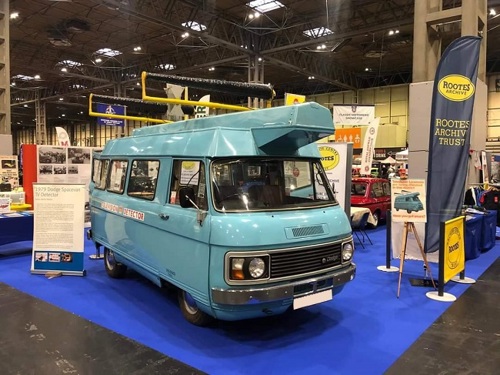MEET THE OWNER – MARTIN MALTAS AND HIS 1979 DODGE TELEVISION LICENCE DETECTOR VAN
02 January 2025
Martin Maltas is the proud custodian of one of the most fascinating vehicles of the 2024 Lancaster Insurance Classic Motor Show – even if it is one you may not have welcomed in the 1970s. Many readers of a certain age will instantly remember this public information film.
The television licence detector van was, of course, a Commer ‘Spacevan’, and Martin’s example is a 1979 model wearing the Dodge badge. The Rootes Group launched the original Commer FC 1500 in 1960, with dealers pointing out its forward control layout, and independent front suspension. The track was also considerably narrower at the front than at the rear, and buyers had a choice of 16 body styles.

Rootes regularly updated the range with more engine and transmission options and a 1967 PB facelift. The line-up became known as the ‘Spacevan’ and the summer of 1976 saw the demise of the Commer marque, replaced by Dodge badges. There was a new black radiator grille in 1977. That year, Commercial Motor reported on a £1.25m Post Office order for 1,185 Dodges. Public utilities had long-favoured the Spacevan, and even after the Peugeot takeover of Chrysler UK in 1978, British Telecom orders meant the final Spacevan left the production line as recently as 1983.
Licence detector vans have been in use for over seventy years. On 1st February 1952, the Post Office demonstrated the pioneer converted Morris-Commercial Y-Type. Earl De La Warr, the Postmaster General, told the press it was estimated that between 100,000 and 150,000 unlicensed television receivers were in use. By the early 1960s the Post Office favoured the Austin A55 Mk. II Cambridge Countryman, and towards the end of the decade, they began using Commers.
In 1972 alone, 22 Commers entered Post Office service. Martin’s father worked in television licence detection in the 1960s and 1970s; he operated one of the first Spacevans, registration YUB 224 J. His son was involved in the same role in the 1980s, and he observes: “It is a myth that the vans were only for deterrent purposes, but the equipment did work, and they did catch people. In fact, the gentleman who designed the electronic equipment visited our stand at the NEC”.
However, the Post Office intended the Commers to incentivise people to buy a television licence; the local press would regularly announce their arrival. One 1970 campaign warned the public: “Our TV detector vans are often called ‘beasts’ because they look like something from a science fiction movie, twirling aerials, winking lights, flashing dials, the works. And like the beast from the movie, the van has a superior intelligence.”
The crew of a detector vehicle consisted of a driver, a postal officer and an operator who sat in a swiveling chair. The detection equipment was designed to pick up signals emitted by the oscillator on a television set. A 1,725cc engine powers the Maltas Dodge, and he finds its progress slow but steady, as it has automatic transmission: “This was because the van was used to crawl around town”.
Martin explains that while the Post Office was awaiting the delivery of a fleet of Leyland Sherpas, they ordered 20 Dodges of which his is number three. They inherited its equipment from the earlier Commers, including the front aerial powered by a belt-driven ‘railway track’. His van initially served in England before transferring to Northern Ireland.
As for the Dodge’s road manners, it has some idiosyncrasies, such as a handbrake that works on the front axle. The handling can be “interesting” due to a front track narrower than the rear, but Martin’s Spacevan is a vital part of the UK’s social history. It is the sole surviving Commer/Dodge detector van, and you can read more about its restoration here.
And while some visitors to the NEC may have uttered rude oaths upon seeing it, many others were fascinated by the Dodge’s bulk and imposing presence. As well as instantly remembering the warning film’s famous line - “And they’re watching Colombo!”.
With thanks to Martin Maltas for his time and for the permission to use the image in this blog.
